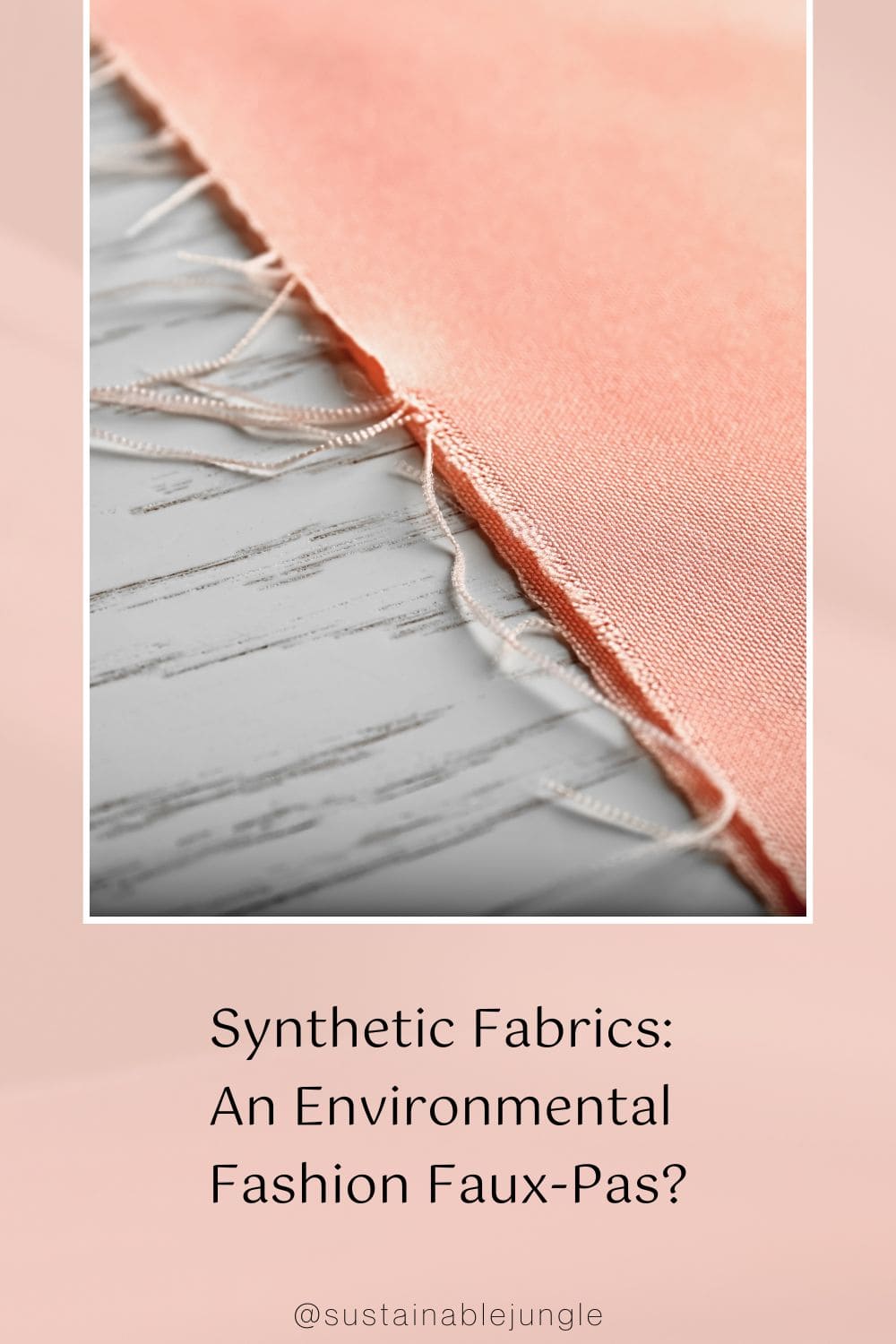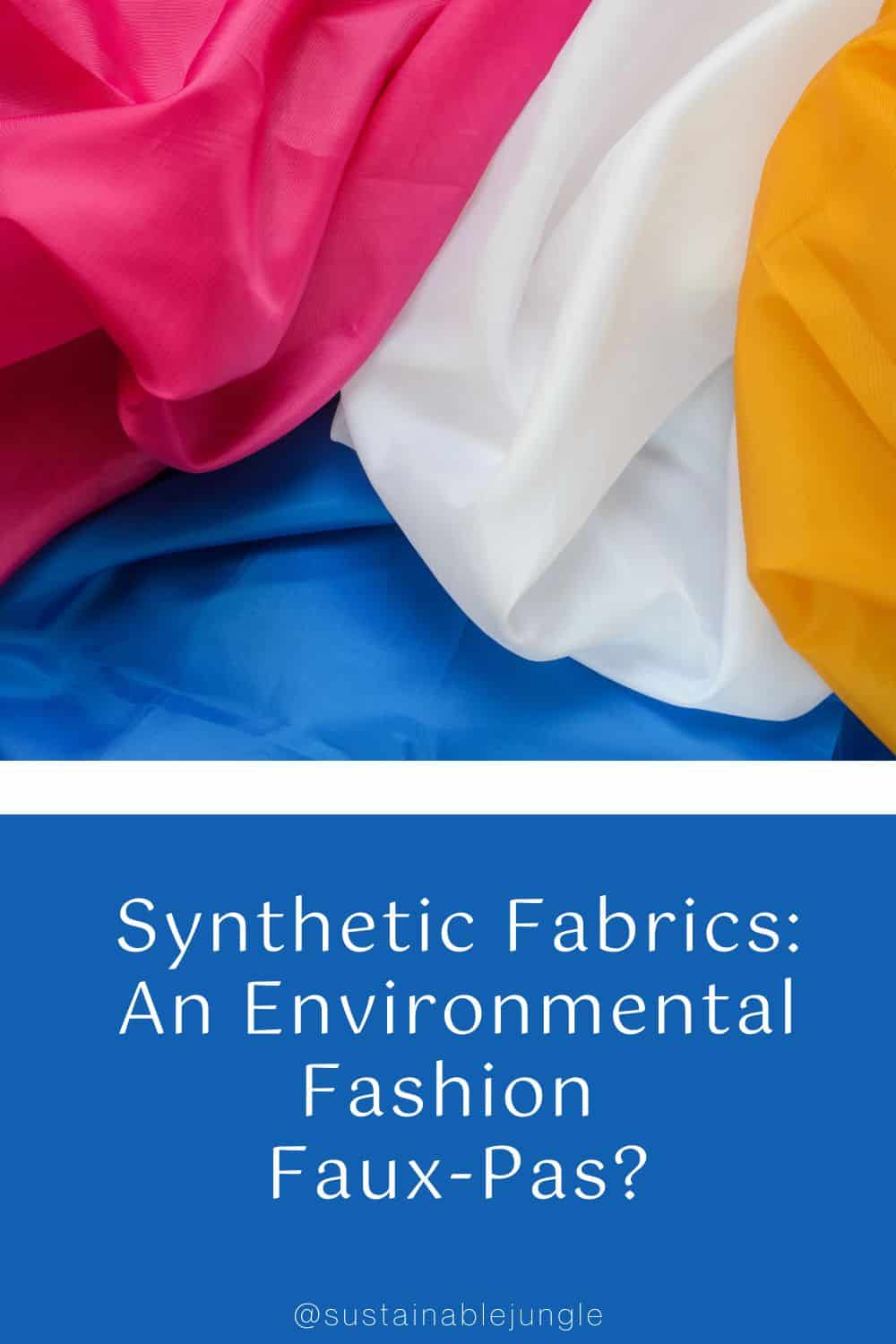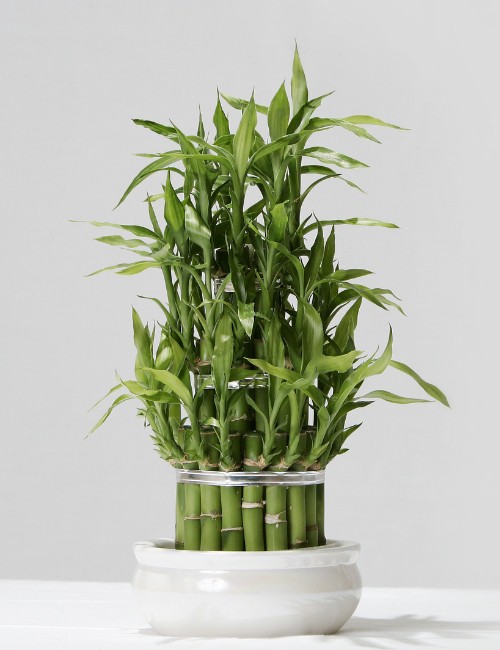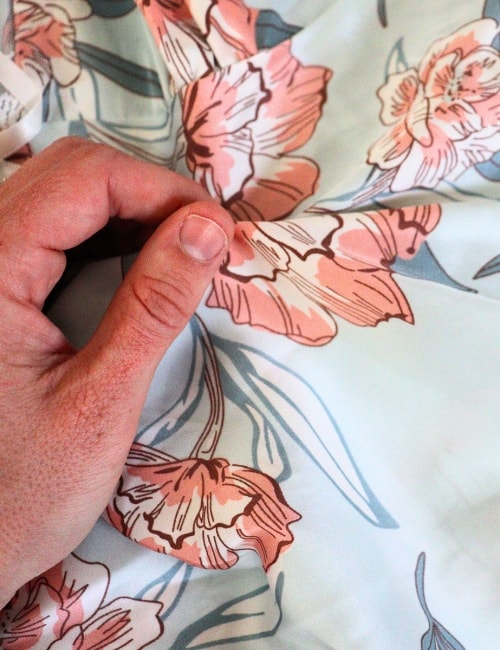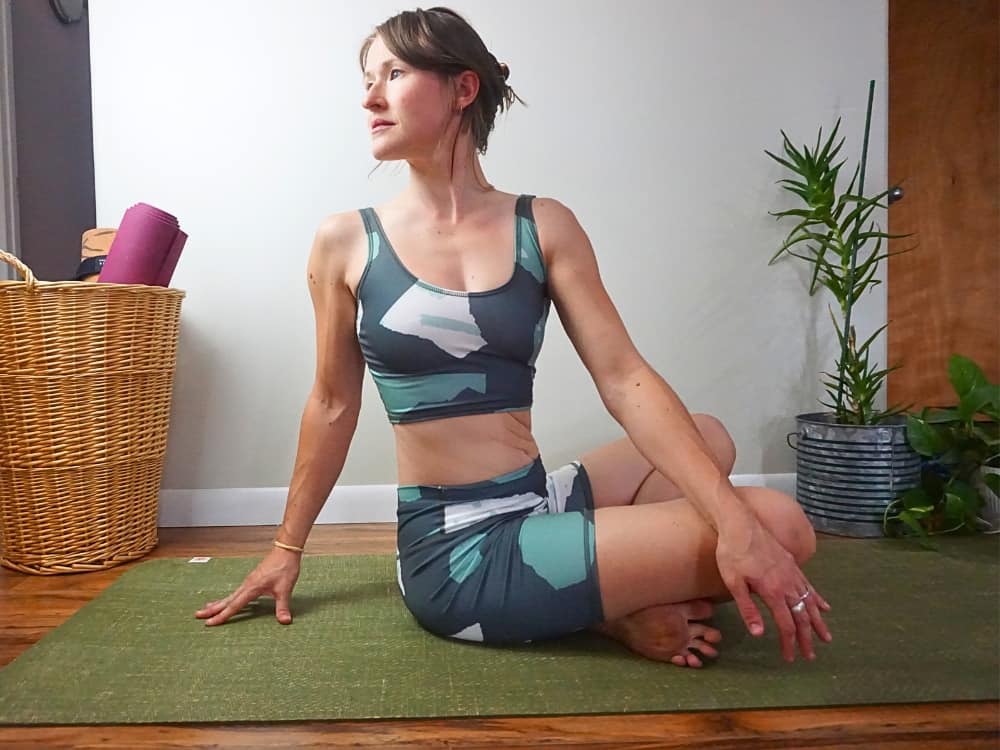
Synthetic Fabrics: An Environmental Fashion Faux-Pas?
Take a look at the label on your clothing.
You won’t see “synthetic fabrics” per se listed, but it’s very likely you’re wearing them. In fact, most of our closets would be fairly empty without synthetics.
Currently, synthetics make up about 60% of our clothes.
Unfortunately for our most important fashion icon (Earth), demand for synthetics is growing faster than the demand for natural fibers.
By 2030, it’s expected synthetics will make up 75% of global apparel fiber production.
But how does that look from an environmental standpoint?
Considering a conventional synthetic textile is made from petroleum-based chemicals, it doesn’t look good.
We want to get to the thread-bare bottom of synthetic fibers to determine if they deserve a hanger in sustainable fashion or not.
1. What Are Synthetic Fabrics?
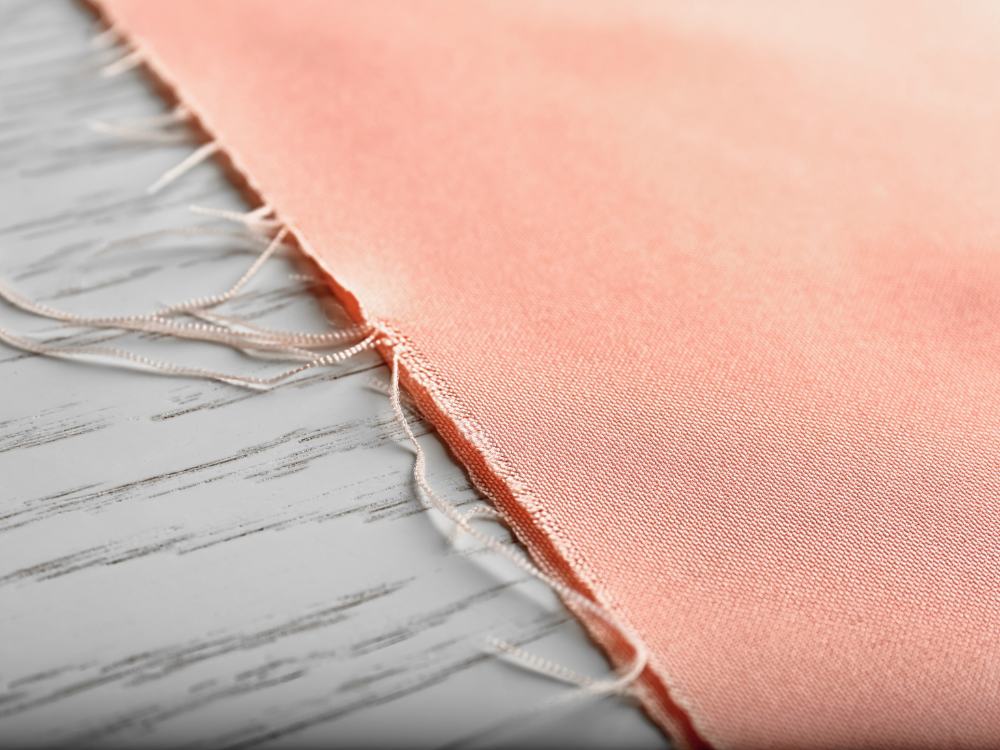
What is synthetic fabric?
According to Merriam-Webster, the synthetic materials’ definition is:
“Any of various man-made textile fibers including usually those made from natural materials (such as rayon and acetate from cellulose or regenerated protein fibers from zein or casein) as well as fully synthetic fibers (such as nylon or acrylic fibers).”
In other words, these artificial fibers are those that are manufactured using man-made materials or fibers rather than natural fibers like cotton, wool, or silk.
So what is synthetic fabric made of?
It differs slightly depending on what synthetic fiber fabrics we’re talking about, but it all boils down to one thing: plastic.
They’re created by taking petroleum and subjecting it to various chemical processes, often involving polymers, and are designed to mimic or replace the properties of natural fibers.
These aren’t to be confused with a semi-synthetic fiber—such as viscose fabric, rayon fabric, lyocell fabric, modal fabric, and bamboo fabric—which are made from plant fibers like wood pulp that undergo chemical processing to soften (i.e. plasticizing).
What are some synthetic fabrics then?
2. Synthetic Fabrics Examples
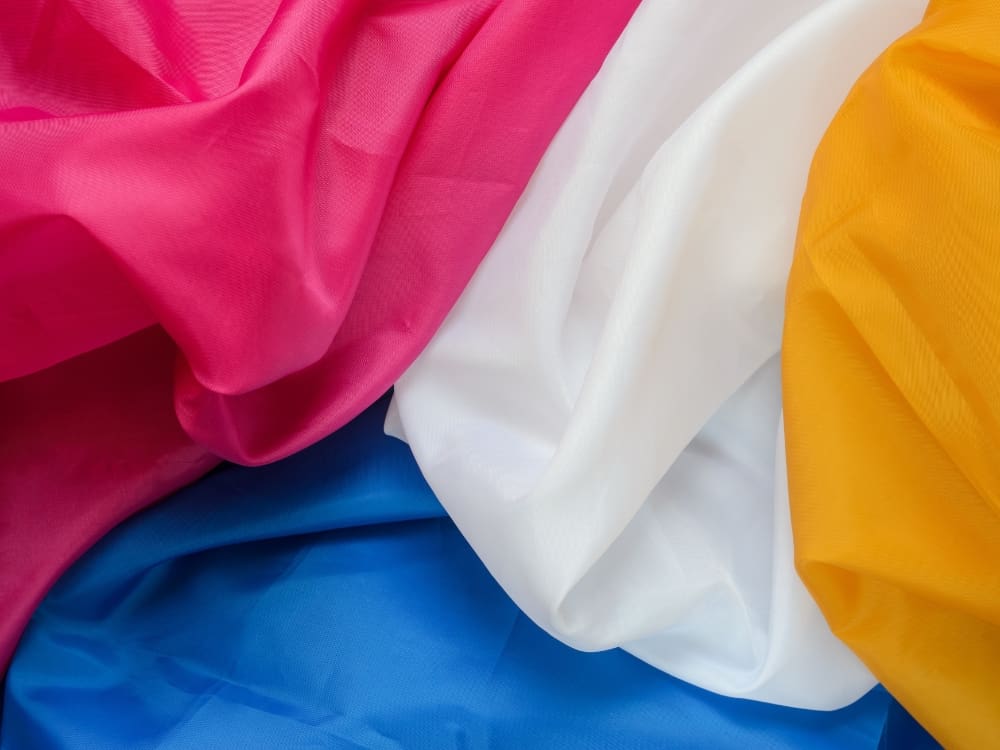
The most common examples of synthetic materials are classified as Synthetic Polymers, or those derived entirely from petroleum and other fossil fuel-based raw materials.
They include:
- Acrylic
- Anidex
- Aramid
- Elastoester
- Fluoropolymer
- Lastrile
- Melamine
- Modacrylic
- Novoloid
- Nylon
- Nitrile
- Olefin
- PBI
- Polyester
- Polypropylene
- Polyvinyl Chloride (PVC)
- Saran
- Spandex
- Vinyl
- Vinyon
As you can see, the synthetic fabrics list is long, but some are more prevalent in use as synthetic clothing material.
Polyester Synthetic Material:
What is the most popular synthetic fiber?
That would be polyester fibers (also known as polyethylene terephthalate, PET, or microfiber), made from petroleum and coal.
It’s durable, stretchable, breathable, and versatile, with the ability to be transformed into something thick and cozy like fleece fabric or thin and moisture-wicking like yoga clothes.
It’s also easily recyclable, both from other synthetic clothing or from recycled plastic bottles and other #1 type of plastic.
Spandex Synthetic Material:
Also known as elastane and lycra, this is a highly-breathable super-stretch fabric which is why it’s one of the most popular contenders for any athletic wear (sustainable leggings and other stretch pants), and is also found in skinny jeans, swimwear, organic bras, and underwear.
It can stretch five to eight times its normal size, all thanks to polyurethane.
While spandex isn’t the worst synthetic fabric out there, it does contribute to its own fair share of environmental degradation.
Unlike polyester and acrylic, it is made from chemicals that are synthesized in the lab (that aren’t derived from coal and petroleum oil).
The biggest issue with spandex is the fact that it makes up a lot of our garment waste. While it is possible for spandex to be recycled, it rarely happens (especially at the post-consumer level).
Acrylic Synthetic Material:
Also known as polyacrylonitrile and acrylonitrile, acrylic fabric is stretchable and moisture-wicking, properties that make it widely used in less-than-sustainable sweaters, sustainable blankets, and other knits.
Acrylic fibers are polymers derived from coal or fossil fuel-based chemicals and are some of the most environmentally damaging among all synthetic materials examples.
Nylon Synthetic Material:
Nylon is widely used in form-fitting apparel like sportswear, swimwear, and yoga pants.
In fact, nylon makes up about 12% of global synthetic fiber production.
The main ingredient in nylon fabric is none other than petroleum oil, which requires an energy-intensive process in order to manufacture the fabric.
Not only that, but nylon releases a lot of waste materials during production, and is known to release a significant amount of nitrous oxide (a greenhouse gas 300 times more potent than CO2).
However, like polyester, nylon is readily recyclable, and companies like ECONYL® are making it easier to find fully recycled sustainable swimwear and other nylon synthetic clothes.
3. Advantages & Disadvantages Of Synthetic Clothing

The history of synthetic materials goes back to the 1800s and starts with an alternative to silk made from mulberry tree bark.
Fast-forward to the 1930s, the world of synthetic fibers really took off with the invention of nylon (patented by chemical giant DuPont in 1935).
It was touted to be a “miracle fiber” and quickly became more popular than many natural fibers.
Synthetic Fibers Vs Non-Synthetic Fabrics
Let’s break down the natural vs synthetic fiber fabrics argument and why consumers would likely choose one over the other.
Synthetic fibers:
- Quick to dry
- Added absorbency
- Water resistant
- Moisture-wicking abilities
- Stretchability
- Stain resistant
- Durability (in some cases)
- Cost, cost, cost
Natural fibers:
- Better for skin
- Better for planet (conventionally-grown cotton may be the exception here, due to its heavy chemical and water requirements)
- Durability
- Quality improves over time for some fabrics (i.e. linen)
- Natural antibacterial / antimicrobial properties
- Biodegradability
- Generally better for workers
While natural fibers may lack some performance benefits, they are clearly the winner if you care about the earth more than cost.
Are the benefits of synthetic ever worth it though?
Advantages Of Synthetic Material Clothing
Synthetic fibers are advantageous most notably because of their affordability. Many artificial fibers have been designed to be an alternative to natural fabrics, which typically means a huge reduction in cost.
Synthetic fibers have also been designed to be stain-resistant, water-resistant, and even waterproof.
They excel particularly well in weather-resistant outerwear and activewear for their breathability and moisture-wicking qualities (whereas natural fabrics like cotton absorb and hold moisture, like sweat).
And do synthetic fabrics shrink?
Some can, but not nearly to the extent that most non-synthetic clothing (i.e organic cotton or ethical wool) does. This means learning how to wash synthetic clothes is generally easier than natural fibers.
However, that’s a double-edged sword because while heat won’t shrink your polyester sweater, you need to exercise greater care when machine drying and ironing synthetic fabrics (which is to say: don’t) so as not to melt the plastic fibers.
For that reason, keep in mind that synthetic clothing is flammable, too, unless treated with chemical flame retardants (ew).
Disadvantages Of Synthetic Material Clothing
Many garments made with synthetic fibers are chemically unstable.
If you’ve owned a $5 tee shirt or $10 pair of leggings, you have likely seen the degradation or discoloration after wearing the garment for just a few months (sometimes even less).
Oftentimes people find they’re allergic to synthetic fibers.
An allergy to polyester, also called textile dermatitis, is a result of the chemical additives used to process the fabric. It can cause a range of symptoms, from mild itching to severe hives and rashes.
Even if an allergy isn’t present, synthetic fibers can still be harmful to human health and are known to produce poisonous gasses when burnt. Nylon and PU-based fabrics, for instance, contain nitrogen in their structure and thus produce hydrogen cyanide (HCN) when burned.
These disadvantages though are minor when you consider what they’re doing to our planet.
First, fossil fuels need to be obtained before undergoing an initial refinement process to become petroleum before being refined again to produce ethylene.
Only then do we get the actual synthetic fibers.
These processes are extremely wasteful and produce toxins and greenhouse gasses which are released into the environment.
Then there’s the human rights abuses along that same supply chain.
The process used to make acrylic fabric, for example, is highly volatile. Workers are continuously exposed to the risk of explosions. If they make it through a 16-hour day safely, they’re constantly exposed to harmful gasses.
Merely coming into contact with acrylic fibers increases our risk of developing cancer.
Acrylic’s biggest, most devastating difference from other synthetic fabrics is that it’s nearly impossible to recycle. Unlike polyester, there’s no good way to dispose of it—it will just accumulate in the environment for hundreds of years.
And this poses the biggest problem of all: microfibers.
Acrylic is the worst offender for the microfiber crisis (polyester coming in second). Let’s dive into the world’s oceans to learn a little more about these microplastics.
4. Why Are Synthetic Materials Bad?

Let’s address the plastic white elephant on the screen: is synthetic fabric bad?
It depends.
On one hand, are synthetic materials useful?
Absolutely. Being able to continuously evolve our wardrobes—especially for those on tighter budgets—certainly wouldn’t have been possible without synthetic fabrics.
The same could be said for all types of industrialization (fashion, food, healthcare, transportation).
It’s provided us with a more convenient lifestyle we’ve grown accustomed to and, to some extent, supported the health and well-being of an ever-growing population.
However, as they say, too much of a good thing can be bad—especially if that thing is made out of plastic.
Are synthetic fabrics sustainable?
There’s a question with an easier answer: NO.
Plastic isn’t biodegradable and even when blended with natural fibers, synthetic fibers take hundreds of years to break down—contributing to the 15.1 million tons of textile waste generated every year.
Synthetics and sustainable fabrics don’t go hand-in-hand, the exception being recycled synthetics made with other recycled synthetic fibers that would have otherwise made their way into landfills, oceans, or the mouths of hungry fish.
However, recycled synthetic fiber clothes still pose a threat when they break down or when they’re washed).
Synthetic Fiber Clothing & Microplastic Pollution
We’re drowning in a literal sea of plastic.
There are 50 million tons of plastic waste in the ocean, as evidenced by horrors like the Great Pacific Garbage Patch (a growing island of plastic trash twice the size of Texas).
Experts predict that by 2050, there will be more plastic than fish in the ocean.
It’s easy to blame all that on single-use plastics (which no doubt play their part), the most insidious culprit is far less obvious.
Microplastics: the tiny pieces of plastic that end up choking our sea.
While not solely responsible, synthetic fabrics are an enormous contributor to microplastic pollution. A report by the International Union for Conservation of Nature found that 35% of ocean microplastics come from synthetic textiles, or about 1.5 million tons per year.
In a typical wash, an astonishing 700,000 microfibers could be released into our environment as microplastics. It’s closer to one million when washing polyester fleece.
While some of these are captured by local wastewater treatment plants, 40% on average slip through and make their way into rivers, lakes, and oceans.
5. How To Minimize Synthetic Fabric Pollution
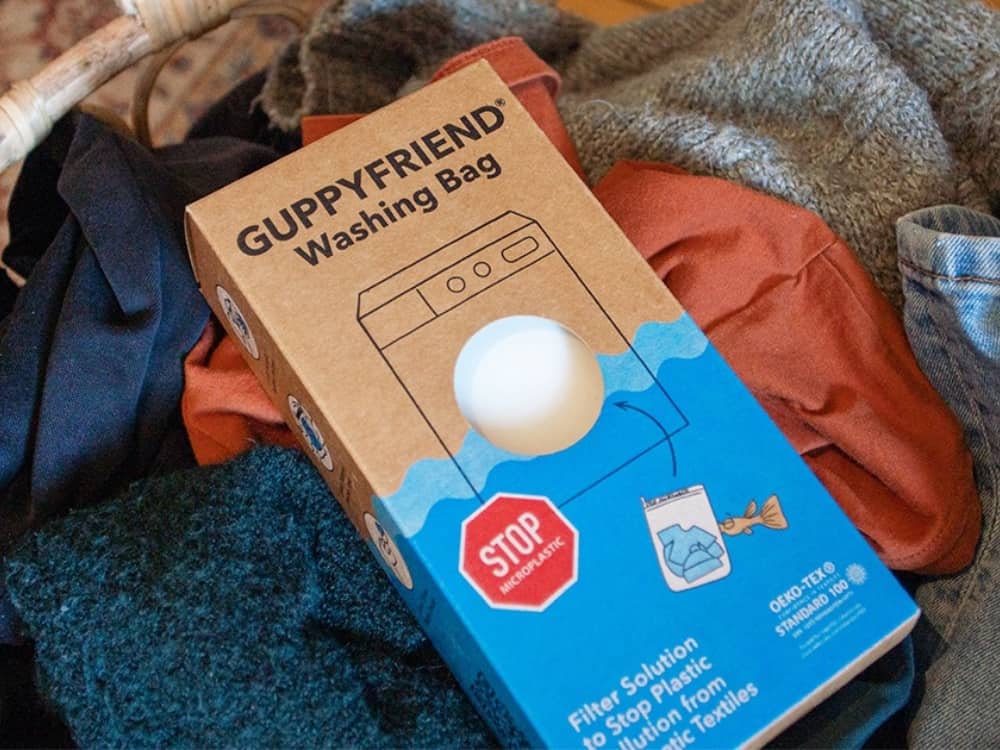
Most clothes already in existence are made of synthetic fibers, so it would be remiss to think we can avoid them completely.
One of the best things you can do to minimize synthetic fabric pollution is to keep synthetics already in existence in use for longer.
Even if all synthetic production ceased today, there are so many synthetic textiles already in existence waiting to be repurposed into synthetic clothes, eco-friendly comforters, sustainable sofas, eco-friendly rugs, and more.
So while it’s a good idea to stop buying new virgin synthetics, it would do more harm than good if we just threw them all away and immediately switched to natural alternatives.
Buying from second hand stores is an excellent way to give synthetic-based clothes and home textiles a second life.
If you’re in the market for new clothes, look into recycled clothing brands incorporating recycled synthetic fabrics into their synthetic clothing lines.
This is especially true for activewear and outdoor clothing, where finding clothes 100% sans synthetics is difficult. Look for clothes that have it at a minimum.
While this negates their potential to biodegrade or compost, small percentages (<10%) of synthetic means largely natural fiber garments (like old jeans that are mostly cotton with a little polyester for stretch) can still be recycled.
Minimizing Microplastic Pollution From Synthetic Fiber Fabrics
For those of you who read your clothing label at the beginning of this article, you likely have one big question: how to wash synthetic clothes without contributing to microplastic pollution?
Fortunately, there are some easy solutions:
- Wash your clothes less: When you do wash your clothes, make sure you’re washing a full load (less friction equals fewer fibers are released).
- Choose a natural laundry detergent: Liquid laundry soap doesn’t loosen as much as abrasive powder detergent particles, so using it can reduce microplastics.
- Use a front-loading eco-friendly washing machine if you can: Microfiber masses from top-loaders are 7x greater than those of front-load machines.
- Use a Guppy Friend wash bag: These fine mesh bags trap the microplastics, so you can collect them and throw them in the garbage (rather than the ocean).
Did you know we Have a Newsletter?
We cover the latest in sustainable living, fashion, zero waste, beauty, travel, finance and more…
Final Thoughts On Synthetic Fabrics
Synthetic fabrics are pretty synful.
On the plus side, it is possible to wear synthetic clothes in a more responsible manner, but it’s also our job as conscious consumers to demand sustainable clothing brands use more responsible fabrics.
They can do so by reducing textile waste, recycling synthetic fabrics, cutting out virgin synthetics altogether in favor of natural materials, transforming plastic pollution into new garments, and all-around stretching out the lives of stretchy stuff.
Now, stretch out and shoot this article into the DMs of everyone you know.
Synthetic materials are here to stay, and they’re likely to be a big part of our lives and the textile industry for many years to come, so help spread the word on how we can make the best of a bad situation.
Pin these:
